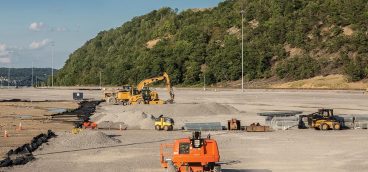Red Flags Rising

It’s been more than a year since Maria van der Hoeven, executive director of the International Energy Agency, stepped to the lectern on a sweltering summer day in Houston and issued a stern warning to a gathering of energy executives.
She acknowledged the potential advantages of the unconventional shale gas boom—from increasing the nation’s energy independence, to shoring up its anemic economic recovery, to reducing carbon output at a time when scientists warn we’ve pumped so much heat-trapping CO2 into our warming atmosphere that we’ve reached levels exceeding any in the past 6,000 years.
All of those advantages, she said, would be jeopardized if the public, mistrustful of the oil and gas industry and skeptical of government’s willingness to police that industry, were to turn against shale development. “There is a very real possibility that public opposition to drilling for shale gas will stop the unconventional gas drilling revolution and fracking in its tracks.”
In April, activists came to Harrisburg with boxes full of petitions—100,000 signatures in all—demanding a moratorium on unconventional gas drilling in Pennsylvania. Few of those who had spent months collecting those signatures expected that they would force the state legislature or the administration to call an immediate halt to drilling operations here, which by then had been going on for eight years.
It was, as one activist put it, “a chance to show the government where we stand.”
At about the same time, a poll of Pennsylvania and Michigan residents conducted by the University of Michigan’s Center for Local, State and Urban Policy and the Muhlenberg College Institute of Public Opinion sounded another warning. Slightly less than half of those interviewed generally supported gas extraction, nearly 60 percent viewed the process as a major risk to water supplies in the state, and fully two-thirds told pollsters they would support a moratorium on drilling until those risks were better understood. But coming as it did, in tandem with the delivery of all of those boxes of signatures calling for a halt on shale development, the Michigan/ Muhlenberg poll raised for many analysts the question of whether we are nearing that tipping point in public opinion that van der Hoeven had warned about.
In some quarters—both in the industry and in that portion of the environmental community that supports shale drilling, albeit reluctantly—there’s been a growing recognition that the public, at least in Pennsylvania, has never been more than, at best, cautious, and has largely been skeptical about promises that the shale boom would bring widespread prosperity without wreaking significant havoc on the environment.
In part, that sense of unease was what prompted four of the major drillers in both the Utica and Marcellus Shales to join with five national, state and regional environmental organizations to establish the Center for Sustainable Shale Development. Announced in March after nearly two years of planning, the project grants a kind of Good Housekeeping Seal of Approval to drillers who meet 15 environmental performance standards as certified by independent auditors—standards that in most cases exceeded those set by the state.
The idea is that the standards set by the center will reassure a skeptical public that the industry and the environmental groups are willing to step up to the plate, and eventually a majority of the drillers will see the program’s value. But it’s been slow going. Most of the major drillers have decided to sit it out for now, and several of the more vocal environmental groups have been harshly critical, arguing that without the force of law, the center and its standards are little more than a publicity stunt.
Time will tell.
But in the meantime, the results of the Michigan/Muhlenberg poll and the comparative strength and resilience of the moratorium movement in Pennsylvania seem to indicate that both the state and the industry have a long way to go to reassure the public. For its part, the Marcellus Shale Coalition, the industry group representing most drillers in the state, insists that neither the recent poll nor the delivery of 100,000 petition signatures demanding a New York State-style drilling moratorium are cause for alarm.
“There’s been a lot of progress since 2011,” said Kathryn Klaber, the coalition’s president and executive director. That year, the anti-shale movement, spurred by things like the public shock over the BP oil spill in the Gulf of Mexico and “on the shoulders” of the aggressively anti-gas film “Gasland,” really began to gain momentum. Since then, Klaber argues, the industry, which has drilled more than 5,000 wells in Pennsylvania alone, has been not only improving its performance but courting public acceptance, and that’s been paying off. “The broader education and understanding of what is happening is in fact increasing the support level.”
Klaber said she was not convinced the poll accurately reflected the more nuanced attitudes of Pennsylvanians toward natural gas development. And as for the moratorium drive, she said, “I don’t pretend to know the source of that, and I haven’t really followed it that closely.” But, she added, “I reject [the] notion that we’re on the verge of a backlash.”
That also seems to be the sentiment within the administration of Gov. Tom Corbett.
“We always need to be mindful of people who want assurance that it’s going to be done right,” said Patrick Henderson, the governor’s point man on all things Marcellus, “and who want not just assurances but verification. We need to respect that.”
But he insists that, as far as the administration is concerned, the 100,000 signatures are more a reflection of the ambition and motivation of “certain groups that are just fundamentally opposed to shale gas development,” than an accurate reflection of attitudes of the majority of state residents.
For a highly motivated group of activists, the whole idea of gas development is anathema, Henderson said. “It goes against their very core. They just will not accept it. They don’t believe it can be done safely, and they don’t want to see, in some cases, I believe, advances in regulation that show that it can be done safely. Because it goes against their core belief. That they can drum up X number of folks and say ‘we are representative of twelve and a half million Pennsylvanians,’ I don’t think that’s accurate.”
He also insists that the poll has been largely taken out of context. “A lot of people think that poll says 59 percent of Pennsylvanians oppose natural gas development. I don’t think that’s what that poll says. I think some who are looking for a sensational headline migrated to that,” he said, adding that he believes the poll was worded in such a way as to lead respondents to ignore advances in regulation and oversight in the eight years since the shale boom began in earnest. “I don’t think that this poll provided any reasonable basis of information to… gauge the awareness of the respondents to what Pennsylvania has done.”
Part of the problem, he insisted, is that the administration and the industry have not done a good enough job of convincing the public that they’re doing enough to minimize the risk, from “updating construction standards for wells,” to reducing the risk of methane migration to “adopting new waste water standards, to increasing penalties to increasing oversight staff. There’s an amazing story on the regulatory side that we need to do a better job of telling.”
But there are those—including leading Democratic contenders for Corbett’s job such as Katie McGinty and John Hanger, both former heads of the state Department of Environmental Protection—who believe that both the poll and the moratorium drive are evidence of a deep and lingering mistrust over the whole issue of gas drilling. They warn that in playing down the significance of both, the administration and much of the industry may be whistling past the graveyard.
“My perspective is this: natural gas promises very significant benefits for our environment and our economy,” said McGinty. Before returning to the private sector, she advised both former President Bill Clinton and former Vice President Al Gore on environmental issues, and she was on President Obama’s short list to head the Environmental Protection Agency when he took office in 2009. “And, as an industrial activity, it also poses environmental and safety issues that need to be addressed effectively.”
The way she sees it, it’s not that the administration or the industry have failed to get their message across, it’s that they’ve developed such a tight bond in the mind of the public that there’s mounting concern that environmental enforcement may be compromised. She contends that the Center for Sustainable Shale Development, despite the fire it has drawn from one side and the collective shrug it has evoked from much of the other, could assuage at least some of the public’s concerns. “I really commend those who have been involved in a very substantive effort.”
But that alone will not be enough, she said.
“I think in enforcement, we’re coming up short,” McGinty said, but even more so, she believes the administration has actually helped stoke the embers of mistrust by consolidating power in Harrisburg—limiting the ability of regulators in the field to go after violators without clearance from DEP higher-ups in Harrisburg, and limiting, through Act 13, the right of local communities to regulate gas development within their jurisdictions—at the same time that the state appeared to be cozying up to the drillers.
“You take all of that together, including the governor’s resistance to a reasonable shale tax,” she said, adding that the upshot is that eyebrows aren’t just being raised among the hard-core anti-drilling faction; it has set off alarms for a lot of people.
So far, McGinty says, the poll and the moratorium petition are expressions of doubt more than expressions of the intractable opposition to shale gas that van der Hoeven and the IEA warned about. But they could be a harbinger of things to come if the state does not take a more aggressive approach than it has with the drillers and draw a brighter line between its interests and the drillers’.
Hanger succeeded McGinty as DEP chief, and was at the helm of that agency during the shale gas boom’s first few expansive years. He sees an even more dire warning in the twin messages that he believes the public is sending through the poll and the moratorium drive.
“I think we are nearing a tipping point,” said Hanger, who has drawn criticism from pro-industry types for advocating tough regulation and from many in the environmental community for his equally strong statements supporting natural gas as part of a multipronged strategy to boost economic development and reduce the state’s carbon footprint. He believes the drillers have contributed a significant portion of what he believes is the growing mistrust.
“The drilling industry continues to just misunderstand the diversity of Pennsylvania,” he said. The way he sees it, the industry believes that all it needs to do is repeat the same message all across the state and eventually it’ll win the hearts and minds of a doubtful public. The problem is that the message of potential prosperity that often resonates in some of the more conservative areas of the state doesn’t sound nearly as good in more affluent areas where people are less likely to see any significant direct benefits and are often more likely to be swayed by questions about the environmental impacts.
“In simple political terms these guys are acting like they’re in a red state when they’re really in an increasingly blue state,” Hanger said.
And by focusing primarily on that message and a single political base, he says, the industry risks playing directly into the existing cultural and political fractures that snake through this state.
By ignoring warning signs of mounting public unease across the state, and insisting that the poll and the moratorium movement reflect the agenda of only a particularly energized anti-shale minority, Hanger argues, both the drillers and the government that’s supposed to oversee them run the risk of marginalizing themselves.
Add to that, he says, the increasingly prevalent narrative, true or not, that has emerged in Pennsylvania that the administration and the legislature are first and foremost interested in promoting shale development and that regulators need to be more tightly regulated themselves—which poses an increasing danger that the potential backlash the IEA predicted could materialize.
“It’s always a mistake to underestimate the public’s mistrust of big business, especially the oil and gas industry,” Hanger said. “And in the public mind, it’s just hard to separate Corbett and the gas industry. They’re almost Siamese twins.”
Only by asserting its independence from the industry can the state and the drillers themselves avert that backlash, Hanger says. “What the drilling industry in Pennsylvania needs most of all is good government.”
Hanger insists that a reasonable severance tax on shale drillers—rather than the impact fee that the state currently imposes on drillers—would serve a dual purpose. Not only would it raise revenues for the fiscally troubled state, but it would likely be perceived as a kind of declaration of independence by Harrisburg from the industry. That, together with a fully developed state energy policy that would promote conservation and prod the deployment of technologies, could help restore flagging confidence in the state’s ability to develop the resource and police it.





